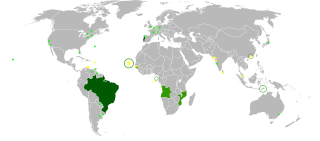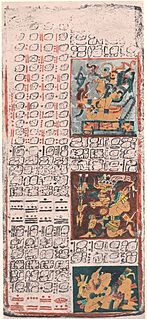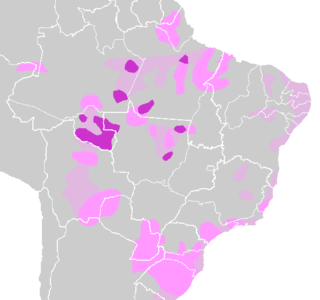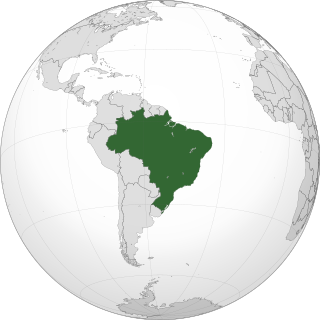See also
| | This disambiguation page lists articles associated with the title Anambe. If an internal link led you here, you may wish to change the link to point directly to the intended article. |
Anambe or Anambé may refer to:
| | This disambiguation page lists articles associated with the title Anambe. If an internal link led you here, you may wish to change the link to point directly to the intended article. |

Brazil, officially the Federative Republic of Brazil, is the largest country in both South America and Latin America. At 8.5 million square kilometers and with over 211 million people, Brazil is the world's fifth-largest country by area and the sixth most populous. Its capital is Brasília, and its most populous city is São Paulo. The federation is composed of the union of the 26 states and the Federal District. It is the largest country to have Portuguese as an official language and the only one in the Americas; it is also one of the most multicultural and ethnically diverse nations, due to over a century of mass immigration from around the world; as well as the most populous Roman Catholic-majority country.

Latin America is a group of countries and dependencies in the Western Hemisphere where Romance languages such as Spanish, Portuguese, and French are predominantly spoken. Some subnational regions such as Quebec and parts of the United States where Romance languages are primarily spoken are not included due to the countries as a whole being a part of Anglo America. The term is broader than categories such as Hispanic America which specifically refers to Spanish-speaking countries or Ibero-America which specifically refers to both Spanish and Portuguese-speaking countries. The term is also more recent in origin.

Portuguese is a Romance language originating in the Iberian Peninsula of Europe. It is the sole official language of Portugal, Angola, Mozambique, Guinea-Bissau, Cape Verde, São Tomé and Príncipe and Brazil while having co-official language status in East Timor, Equatorial Guinea and Macau. A Portuguese-speaking person or nation is referred to as "Lusophone" (lusófono). As the result of expansion during colonial times, a cultural presence of Portuguese and Portuguese creole speakers are also found around the world. Portuguese is part of the Ibero-Romance group that evolved from several dialects of Vulgar Latin in the medieval Kingdom of Galicia and the County of Portugal, and has kept some Celtic phonology and lexicon.

South America is a continent entirely in the Western Hemisphere and mostly in the Southern Hemisphere, with a relatively small portion in the Northern Hemisphere. It can also be described as a southern subcontinent of the Americas. The reference to South America instead of other regions has increased in the last decades due to changing geopolitical dynamics.

Indigenous languages of the Americas are spoken by indigenous peoples from Alaska, Nunavut, and Greenland to the southern tip of South America, encompassing the land masses that constitute the Americas. These indigenous languages consist of dozens of distinct language families, as well as many language isolates and unclassified languages.

Tupi–Guarani is the name of the most widely distributed subfamily of the Tupian languages of South America. It includes fifty languages, including the best-known languages of the family, Guarani and Old Tupi.

Brazilian Portuguese is a set of dialects of the Portuguese language native to Brazil and the most influential form of Portuguese worldwide. It is spoken by almost all of the 200 million inhabitants of Brazil and spoken widely across the Brazilian diaspora, today consisting of about two million Brazilians who have emigrated to other countries.
Hunsrik, also called Riograndenser Hunsrückisch, is a Moselle Franconian language derived primarily from the Hunsrückisch dialect of West Central German. The language has some recognition mainly in Brazil. It is an integral part of the historical and cultural heritage of Rio Grande do Sul since 2012, and is considered an immaterial cultural heritage of Santa Catarina since 2016. It is also a co-official language in the municipalities of Antônio Carlos, Santa Maria do Herval and São João do Oeste. In Brazil, Hunsrik is spoken in the states of Rio Grande do Sul, Santa Catarina and Paraná. The language is also spoken in some regions of the Northeast of Argentina and Southeast of Paraguay.
Aan is a 1952 Indian film.
Latin Americans are the citizens of the Latin American countries and dependencies. Latin American countries are multi-ethnic, home to people of different ethnic and national backgrounds. As a result, some Latin Americans do not take their nationality as an ethnicity, but identify themselves with both their nationality and their ancestral origins. Aside from the indigenous Amerindian population, all Latin Americans or their ancestors immigrated since 1492. Latin America has the largest diasporas of Spaniards, Portuguese, Black Africans, Italians, Lebanese and Japanese in the world. The region also has large German, French, and Jewish diasporas.
Brazilian Sign Language (BSL) is the sign language used by deaf communities of urban Brazil. It is also known as Libras and variously abbreviated as LSB, LGB or LSCB.

Portuguese is the official and national language of Brazil and is widely spoken by most of the population. The Portuguese dialects spoken in Brazil are collectively known as Brazilian Portuguese. The Brazilian Sign Language also has official status at the federal level.
Anambé, or more specifically Anambe of Cairari, is a possibly extinct Tupi language spoken in Pará, on the Cairari River in Brazil. It is being supplanted by Portuguese.

The following outline is provided as an overview of and topical guide to South America.
The Anambé are an indigenous people of Brazil, living in the state of Pará, Brazil.
Guajá, or Awá, is a geographically isolated Tupi–Guarani language spoken in Brazil. The extinct 'Anambé' recorded by Ehrenreich may have been a distinct language.
The Xingu languages are a subgroup of the Tupi–Guarani language family.
The Northern Tupi–Guarani languages are a subgroup of the Tupi–Guarani language family.